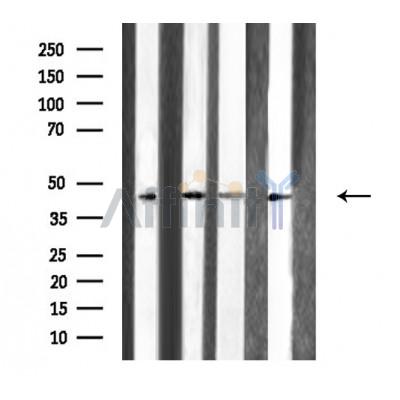ARFIP1 Antibody - #DF3790
| Product: | ARFIP1 Antibody |
| Catalog: | DF3790 |
| Description: | Rabbit polyclonal antibody to ARFIP1 |
| Application: | WB IHC IF/ICC |
| Reactivity: | Human, Mouse, Rat |
| Prediction: | Pig, Zebrafish, Bovine, Horse, Sheep, Rabbit, Dog, Xenopus |
| Mol.Wt.: | 40 KD; 42kD(Calculated). |
| Uniprot: | P53367 |
| RRID: | AB_2836147 |
Related Downloads
Protocols
Product Info
*The optimal dilutions should be determined by the end user. For optimal experimental results, antibody reuse is not recommended.
*Tips:
WB: For western blot detection of denatured protein samples. IHC: For immunohistochemical detection of paraffin sections (IHC-p) or frozen sections (IHC-f) of tissue samples. IF/ICC: For immunofluorescence detection of cell samples. ELISA(peptide): For ELISA detection of antigenic peptide.
Cite Format: Affinity Biosciences Cat# DF3790, RRID:AB_2836147.
Fold/Unfold
ADP ribosylation factor interacting protein 1; ADP-ribosylation factor-interacting protein 1; Arfaptin; Arfaptin-1; ARFIP 1; Arfip1; ARFP1_HUMAN; HSU52521; MGC117369;
Immunogens
A synthesized peptide derived from human ARFIP1, corresponding to a region within the internal amino acids.
Ubiquitously expressed. Higher levels in liver, pancreas, placenta, skeletal muscle and heart.
- P53367 ARFP1_HUMAN:
- Protein BLAST With
- NCBI/
- ExPASy/
- Uniprot
MAQESPKNSAAEIPVTSNGEVDDSREHSFNRDLKHSLPSGLGLSETQITSHGFDNTKEGVIEAGAFQGSPAPPLPSVMSPSRVAASRLAQQGSDLIVPAGGQRTQTKSGPVILADEIKNPAMEKLELVRKWSLNTYKCTRQIISEKLGRGSRTVDLELEAQIDILRDNKKKYENILKLAQTLSTQLFQMVHTQRQLGDAFADLSLKSLELHEEFGYNADTQKLLAKNGETLLGAINFFIASVNTLVNKTIEDTLMTVKQYESARIEYDAYRTDLEELNLGPRDANTLPKIEQSQHLFQAHKEKYDKMRNDVSVKLKFLEENKVKVLHNQLVLFHNAIAAYFAGNQKQLEQTLKQFHIKLKTPGVDAPSWLEEQ
Predictions
Score>80(red) has high confidence and is suggested to be used for WB detection. *The prediction model is mainly based on the alignment of immunogen sequences, the results are for reference only, not as the basis of quality assurance.
High(score>80) Medium(80>score>50) Low(score<50) No confidence
Research Backgrounds
Plays a role in controlling biogenesis of secretory granules at the trans-Golgi network. Mechanisitically, binds ARF-GTP at the neck of a growing secretory granule precursor and forms a protective scaffold. Once the granule precursor has been completely loaded, active PRKD1 phosphorylates ARFIP1 and releases it from ARFs. In turn, ARFs induce fission. Through this mechanism, ensures proper secretory granule formation at the Golgi of pancreatic beta cells.
Phosphorylated by PRKD1; phosphorylation delocalizes ARFIP1 from the Golgi and disrupts its ability to inhibit the activity of ADP-ribosylation factor, an important component of the vesicle scission machinery.
Golgi apparatus. Golgi apparatus>trans-Golgi network membrane.
Ubiquitously expressed. Higher levels in liver, pancreas, placenta, skeletal muscle and heart.
Restrictive clause
Affinity Biosciences tests all products strictly. Citations are provided as a resource for additional applications that have not been validated by Affinity Biosciences. Please choose the appropriate format for each application and consult Materials and Methods sections for additional details about the use of any product in these publications.
For Research Use Only.
Not for use in diagnostic or therapeutic procedures. Not for resale. Not for distribution without written consent. Affinity Biosciences will not be held responsible for patent infringement or other violations that may occur with the use of our products. Affinity Biosciences, Affinity Biosciences Logo and all other trademarks are the property of Affinity Biosciences LTD.


